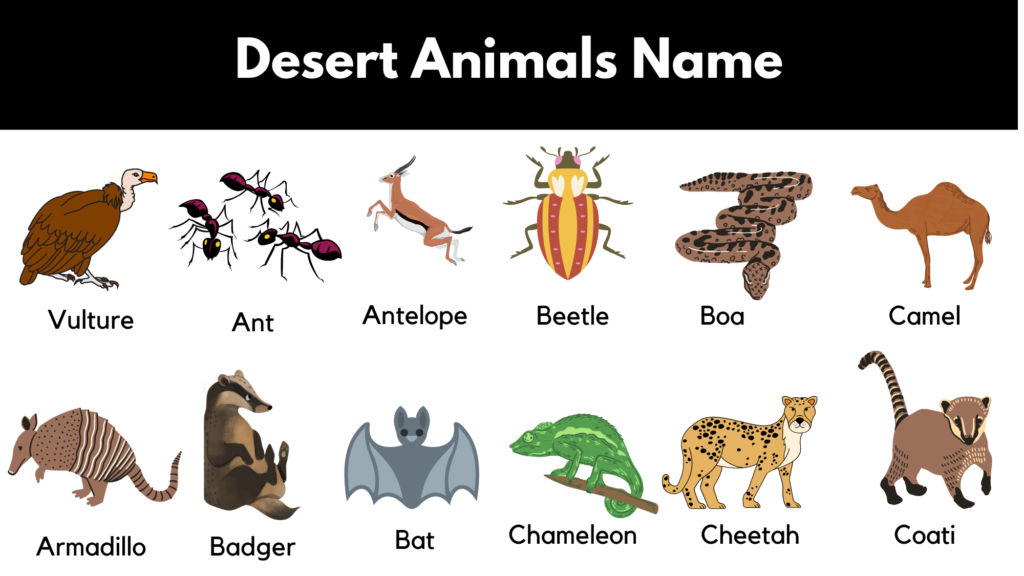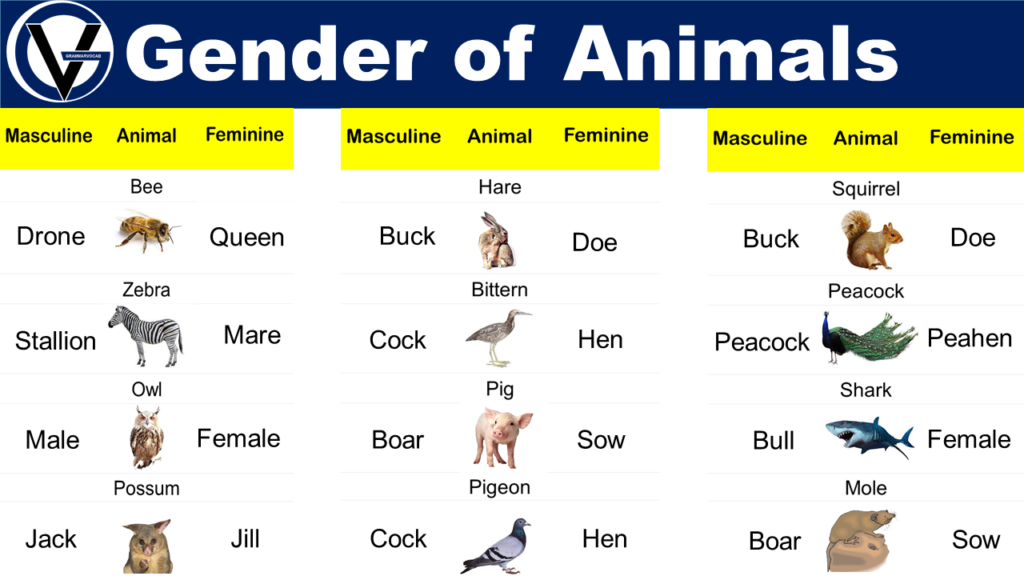If you’re curious about the animals that live in the desert, you’ve come to the right place. In this blog post, we have put together desert animals list with pictures & facts for you to explore. These animals have special adaptations that help them survive in hot and dry places. You’ll learn about the Fennec Fox, which has big ears and comes out at night, and the Sidewinder Snake, which can move quickly on sandy ground. We’ll also introduce you to the Dromedary Camel, known for its ability to go without water for a long time, and the clever Burrowing Owl, which makes its home underground to escape the heat. Whether you love animals or just want to know more about the desert, this list of desert animals will show you the amazing and interesting creatures that live in these harsh environments.
Download Desert Animals Pictures with Names PDF
What Are Desert Animals?
Desert animals are animals that live in the desert. They have special features that help them survive in the hot and dry environment. Some examples of desert animals are camels, kangaroo rats, fennec foxes, scorpions, snakes, and lizards. These animals can store water, save water, and tolerate high temperatures. They also have ways to find food in the desert. These adaptations help them live and thrive in the harsh desert conditions.
Animals that Live in Desert
- Aardwolf
- Addax
- Addax antelope
- African Wild Ass
- African Wild Dog
- Ant
- Antelope
- Arabian Wildcat
- Armadillo
- Baboon
- Bactrian camel
- Bactrian Camel (two humps)
- Badger
- Bat
- Bear (Black)
- Bearded Dragon
- Beetle
- Bighorn sheep
- Bison – Beefalo
- Black widow spider
- Black-footed Cat
- Boa
- Bobcat
- Brown Bear
- Buffalo (Plains Bison)
- Burros
- Bustard
- Cairo Spiny Mouse
- California Wolf Center
- Camel
- Caracal
- Centipede
- Chameleon
- Cheetah
- Chipmunk, Panamint
- Climbing Mouse
- Coati
- Cobra
- Collared Peccary
- Coral snake
- Cotton Rat
- Cottontail Rabbit
- Cottontails
- Cougar
- Courser
- Coyote
- Desert monitor
- Desert Shrew
- Dingo
- Dinosaurs
- Dinosaurs Q&A
- Dolphin
- Eagle
- Echidna
- Elephant
- Elk
- Emu
- Falcon
- Fennec fox
- Ferret
- Finback Whale
- Fire ant
- Fly
- Fox
- Frogmouth
- Gecko
- Gerbil
- Gila monster
- Giraffe
- Gopher
- Grasshopper
- Gray Fox
- Guanaco
- Gundi
- Hamster
- Hawk
- Hedgehog
- Hippopotamus
- Hyena
- Hyrax
- Iguana
- Jack Rabbits
- Jackal
- Jackrabbit
- Jaguars
- Jerboa
- Kit Fox
- Leopard
- Lion
- Lizard
- Long-Tailed Weasel
- Macaw
- Mountain Lion
- Mule Deer
- Oryx
- Ostrich
- Otter – River
- Owl
- Peccary
- Porcupine
- Prairie Dogs
- Pronghorn
- Python
- Quail
- Rabbit
- Raccoon
- Rattlesnake
- Red Kangaroo
- Rhinoceros
- River Otter
- Roadrunner
- Sand Cat
- Scorpion
- Skunk
- Snow Leopard
- South African lion
- Spectacled Bear
- Spiny Mouse
- Spotted Hyena
- Squirrel
- Starling
- Stick Bug
- Tarantula
- Tit
- Toad
- Tortoise
- Tyrant Flycatcher
- Viper
- Vulture
- Waxwing
- Weasel, Long-Tailed
- Whale – Finback
- White Tail Deer
- Wild Burros
- Wild Horses
- Wolf spider
- Wolves
- Woodrats (Pack Rats)
- Xerus
- Zebra
Interesting Facts about Desert Animals
Desert animals have evolved unique adaptations to survive in the harsh and arid environments they inhabit. Here are some interesting facts about desert animals:
- Camel: Camels are known as the “ships of the desert” due to their ability to travel long distances without water. They have humps on their backs that store fat, which can be converted into water and energy when needed. Additionally, they can close their nostrils to keep out sand and have thick, tough skin to protect against the sun and sandstorms.
- Desert Beetle: Some species of desert beetles have developed an interesting adaptation to survive in arid environments. These beetles have specialized bumps on their exoskeleton that collect water from the morning fog. The collected water then trickles down to the beetle’s mouth, providing a vital source of hydration.
- Desert Hedgehog: The desert hedgehog, also called the desert hedgehog or Brandt’s hedgehog, is a species of hedgehog found in desert regions of Central Asia. It has the ability to curl up into a ball, presenting its spiky exterior as a defense mechanism against predators.
- Desert Hedgehog: The desert hedgehog, also known as the long-eared hedgehog, is found in the deserts of North Africa and the Middle East. It has long ears that help regulate its body temperature, and its spines are modified hairs that provide protection against predators.
- Desert Horned Viper: The desert horned viper is a venomous snake found in deserts across North Africa and the Arabian Peninsula. It has distinctive horn-like scales above its eyes, which give it its name. These scales serve as a defense mechanism, helping to protect the snake’s eyes when it burrows in the sand.
- Desert Monitor Lizard: The desert monitor lizard, also known as the white-throated monitor, is found in the deserts of North Africa and the Arabian Peninsula. It has specialized nostrils that can close to prevent sand from entering and is an excellent climber, using its sharp claws to scale rocks and trees.
- Desert Tortoise: The desert tortoise is a reptile that lives in the arid regions of North America. It has adapted to the desert by being able to go without water for long periods. The desert tortoise can store water in its bladder, and during droughts, it can reabsorb this water to survive.
- Dromedary Camel: The dromedary camel, also known as the Arabian camel, is well-suited for desert life. Besides its hump, it has other adaptations that allow it to thrive in extreme heat. It can close its nostrils to protect against sandstorms, and its thick eyelashes and bushy eyebrows shield its eyes from blowing sand.
- Fennec Fox: The Fennec fox is a small nocturnal fox found in the Sahara Desert. It has incredibly large ears that help dissipate heat and enable it to hear prey underground. These ears also help it locate other fennec foxes over long distances.
- Gila Monster: The Gila monster is one of the two venomous lizards in the world and is found in the deserts of the southwestern United States and northern Mexico. Its venom is used to immobilize prey, and interestingly, it is one of the few venomous animals that lay eggs rather than give birth to live young.
- Jerboa: The jerboa is a small rodent that is found in the deserts of Asia and Africa. It has long hind legs, which allow it to move quickly by hopping like a kangaroo. Jerboas are adapted to the arid environment and can survive without drinking water, obtaining moisture from their food instead.
- Kangaroo Mouse: The kangaroo mouse is a small rodent found in the deserts of North America. It has elongated hind legs like a kangaroo, which enable it to move quickly and efficiently across the sand. These mice are primarily nocturnal and have the ability to survive without drinking water, obtaining moisture from their food.
- Kangaroo Rat: The kangaroo rat is a small rodent found in North American deserts. It has large hind legs for hopping and can leap up to 9 feet (2.7 meters) in a single bound. These rats have specialized kidneys that enable them to concentrate their urine and conserve water efficiently.
- Sahara Ant: The Sahara ant, also known as the Saharan silver ant, is a species of ant found in the Sahara Desert. These ants have evolved special adaptations to withstand the scorching desert heat. Their silvery hairs reflect sunlight, reducing heat absorption, and they can move quickly across the hot sand to forage for food.
- Sidewinder Snake: The sidewinder is a venomous snake found in the deserts of North America. It has a unique way of moving across the hot sand. Instead of slithering, it moves sideways, creating “tracks” in the sand that resemble the letter “J.” This sidewinding motion helps the snake minimize the amount of its body surface touching the hot sand, reducing heat absorption.
- Thorny Devil Lizard: The thorny devil lizard, native to the deserts of Australia, has a remarkable camouflage adaptation. Its skin coloration and texture resemble the rough surface of desert sand and rocks, making it almost invisible to predators. It can even change its color to match its surroundings.
- Thorny Devil: The thorny devil, also known as the moloch, is a lizard found in the deserts of Australia. It has a unique appearance with spiky scales that help protect it from predators. The thorny devil also has a remarkable water collection system. It can absorb water through its skin, and the grooves between its spiky scales direct water toward its mouth.
Frequently Asked Questions
Q: How do desert animals survive in such extreme conditions?
A: Desert animals have evolved several adaptations to survive in deserts. Some of these adaptations include:
- Water conservation: They have the ability to extract and retain water from the food they eat or the environment.
- Nocturnal behavior: Many desert animals are active during cooler nights to avoid extreme daytime heat.
- Burrowing: Some species dig burrows underground to escape temperature extremes and reduce water loss.
- Camouflage: Desert animals often have coloration or patterns that help them blend into the sandy or rocky environment, providing protection from predators.
- Specialized diet: They have adapted to feed on a variety of desert plants, insects, or other animals that are available in harsh desert conditions.
Q: Are there any reptiles found in deserts?
A: Yes, reptiles are well-adapted to desert environments due to their ability to conserve water. Several reptiles found in deserts include snakes (such as the sidewinder and rattlesnake), lizards (such as the Gila monster and desert iguana), and tortoises (such as the desert tortoise and the gopher tortoise).
Must Try:
List of grassland animals in English with pictures
List of smart animals known for their intelligence
Animals with their baby’s name
Desert Animals Pictures with Names





